12 Forts of Chhatrapati Shivaji Maharaj UNESCO Forts World Heritage List
Introduction
UNESCO recently added 12 forts connected to Chhatrapati Shivaji Maharaj to its list of World Heritage Sites, marking a significant acknowledgment of India’s architectural and cultural magnificence. These Shivaji Maharaj UNESCO Forts, which can be found all over Maharashtra and parts of South India, are more than just stone constructions; they are colorful representations of Maratha bravery, strategic warfare, and superior architecture. This inclusion honors a monarch whose fortresses served as the cornerstone of Swarajya and continue to motivate future generations.
This blog post explores the significance of each fort in detail, showing why these buildings have endured and how they currently function on a worldwide scale. Additionally, it offers a more comprehensive account of their strategic, historical, and cultural significance to the Maratha Empire and to India in general.
Who Was Chhatrapati Shivaji Maharaj?
The Maratha Empire in western India was founded by Chhatrapati Shivaji Maharaj (1630–1680). He was a visionary leader, a fearless warrior, an accomplished administrator, and a champion for the well-being of his people. He was born at the Shivneri Fort, which is close to Pune. The network of forts that served as the foundation of Shivaji’s military strategy, his secular governance, and his guerilla warfare techniques are what made him most famous.
For Shivaji, forts were more than just military installations; they were also administrative hubs, representations of Maratha identity, and symbols of sovereignty. He was a strong believer in the ability of strongholds situated in key areas, like coastal points and mountain peaks, to defend his kingdom and increase its power. He was in charge of more than 300 forts at the time of his passing.Twelve of them have now been approved by UNESCO due to their historical and cultural significance.
These forts served multiple purposes:
- Administrative headquarters
- Military defense posts
- Safe shelters during conflict
- Cultural and religious centers
With an unmatched knowledge of topography, water resources, and natural fortification, Shivaji Maharaj created his forts. His forts differ from conventional Mughal or British structures due to the combination of human ingenuity and natural geography.
UNESCO World Heritage: What Does It Mean?
A landmark or place has exceptional universal value for humanity when it is named a World Heritage Site by the United Nations Educational, Scientific, and Cultural Organisation (UNESCO). Its significance in culture, history, architecture, science, or nature may be the cause of this. These locations are regarded as treasures that belong to everyone on the planet, not just the country in which they are found.
A site must meet at least one of the ten UNESCO criteria—which include being an exceptional example of traditional human settlement or land use, demonstrating an important interchange of human values, or representing a masterpiece of human creative genius—in order to be designated as such.
Significance for India and the 12 Forts:
The addition of these 12 forts connected to Chhatrapati Shivaji Maharaj has several significant effects on India:
1. 🌍 Global Recognition and Cultural Diplomacy
These forts now stand alongside the Taj Mahal, the Ajanta-Ellora Caves, and other wonders on a distinguished international list. This provides soft power in addition to recognition. India can now use its heritage to strengthen diplomatic and cultural ties by showcasing Maratha history on a global scale.
2. 🚀 Boost in International Tourism
Foreign researchers and tourists frequently flock to UNESCO sites. Increased tourism in Tamil Nadu and Maharashtra could generate jobs and revenue for the local economies with the right infrastructure and storytelling.
3. 💰 Funding and Preservation Support
Due to their World Heritage designation, these forts are eligible to:
- Foreign awards
- Knowledge of conservation
- UNESCO, ICOMOS, and heritage organisations’ technical assistance
- This guarantees that the buildings will be preserved for upcoming generations, particularly those that are at risk from neglect, overtourism, or climate change.
4. 🧠 Educational and Academic Opportunities
These forts serve as practical classrooms for:
- Archaeologists, architects, and historians
- Military academics and civil engineers
- Students in schools and colleges
- Additionally, they advocate for the inclusion of Maratha history in heritage case studies and international academic curricula.
5. 🏛️ Legal and Conservation Obligations
International law requires the Indian government to safeguard these sites after they are recognised. To guarantee minimal damage, no encroachment, and responsible tourism practices, local authorities must also work with UNESCO and heritage boards.
Long-Term Impact
These forts are more than just stone monuments; they are representations of identity, inventiveness, and resistance. Using this UNESCO designation:
- Their tales will be shared online, in classrooms, and in museums around the world.
- They participate in global cultural events and exchange initiatives.
- It is possible to preserve and revitalise regional customs, folklore, and ceremonies associated with the forts.
The 12 Forts of Chhatrapati Shivaji Maharaj: In-Depth Overview
1. Raigad Fort
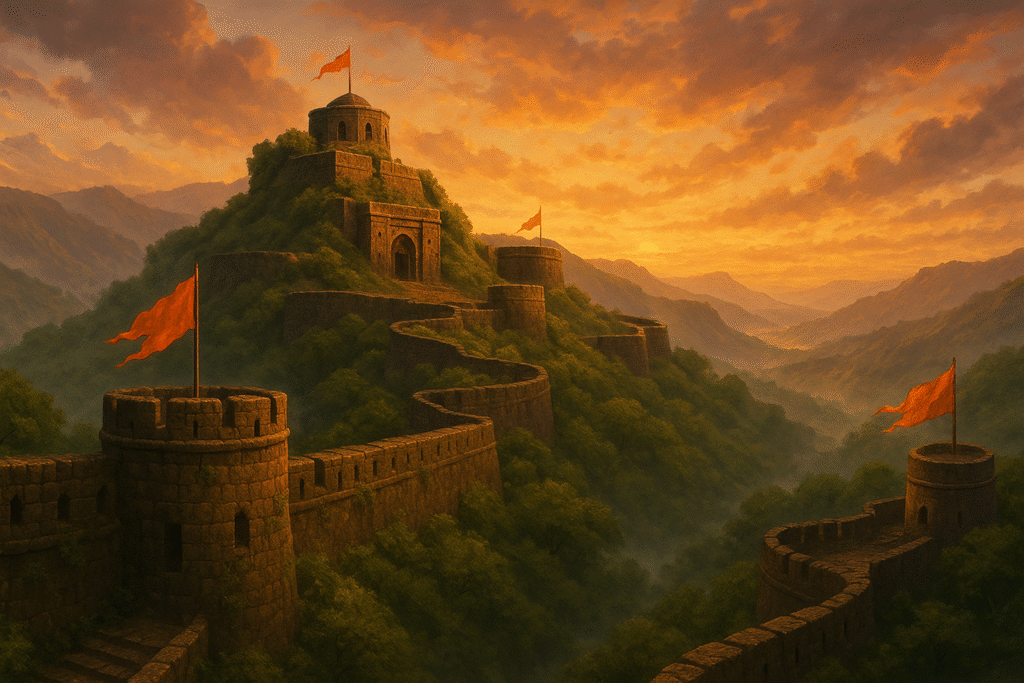
Location: Raigad District, Maharashtra
Altitude: 2,700 feet above sea level
In 1674, Shivaji Maharaj was crowned at Raigad Fort, which served as the capital of the Maratha Empire. The fort’s strategic location made it nearly impossible to reach from three directions. It had marketplaces, storage rooms, water tanks, public durbars, and residential areas. The Samadhi (memorial) of Shivaji and his devoted dog is also located within the fort.
Key Features:
- The Main Gate, or Maha Darwaza
- Takmak Tok (point of execution)
- The Royal Court’s Rajsabha Hall
- Temple of Jagdishwar
- Balekilla (Upper Fort)
- Accessibility of ropeways
2. Rajgad Fort
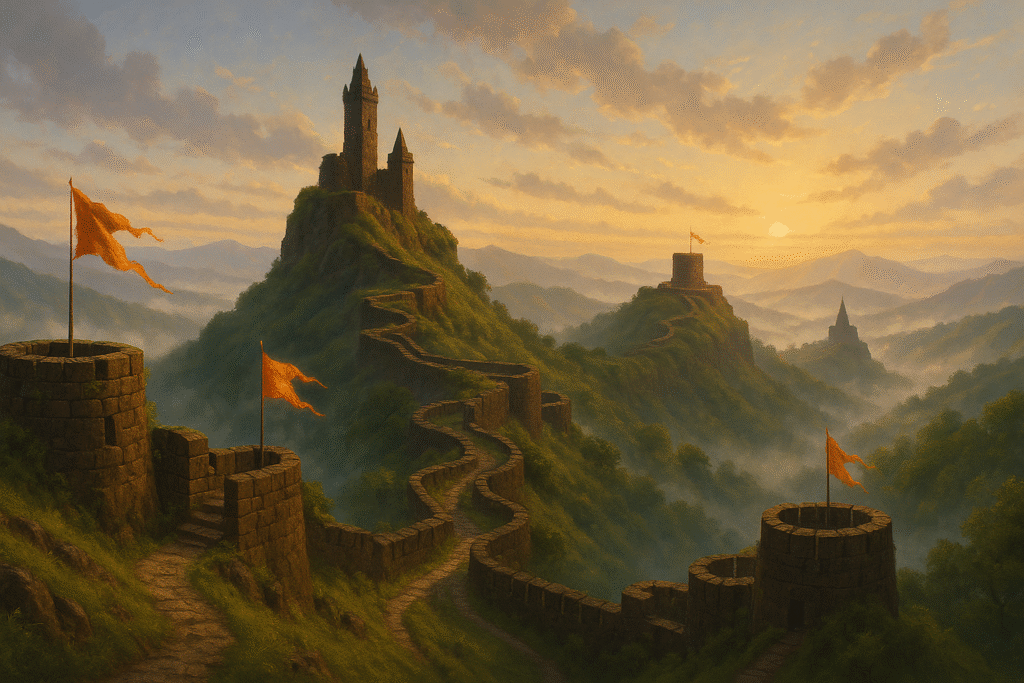
Location: Pune District
Rajgad was Shivaji’s capital for more than 25 years prior to Raigad. At 4,250 feet, it is dispersed throughout a sizable mountain range. The escape of Shivaji from Agra and important Maratha court meetings were among the significant historical occurrences that Rajgad witnessed.
Key Features:
- Citadel of Balekilla
- Lake and Padmavati Temple
- (Secret Entrance) Chor Darwaza
- Sanjeevani and Suvela Machi (Defensive Outposts)
- surrounded by natural barriers and deep valleys
3. Shivneri Fort
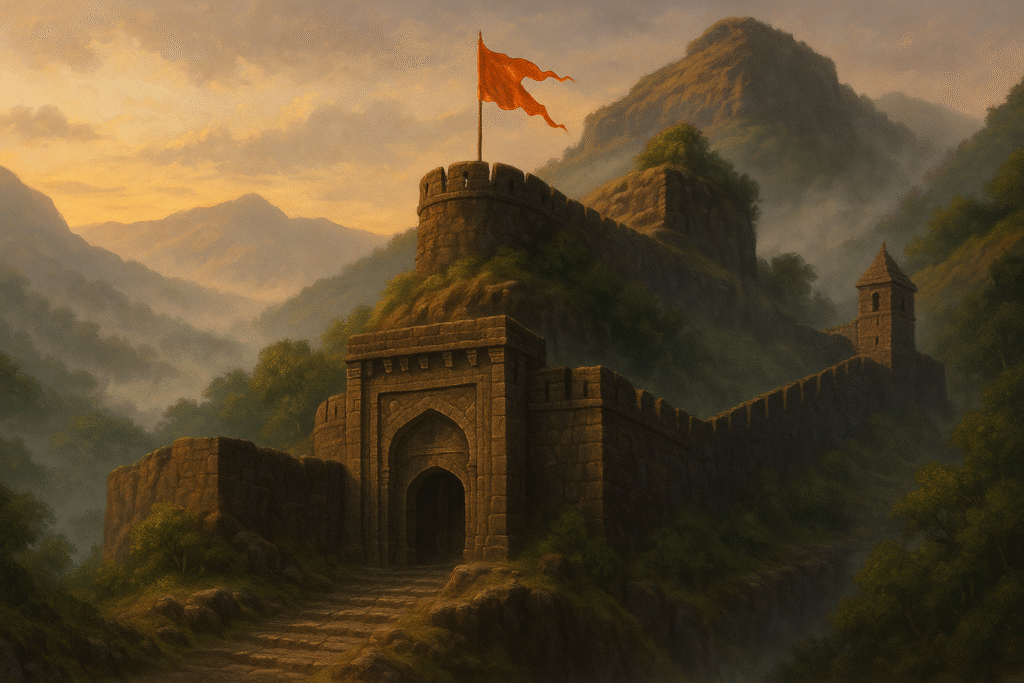
Location: Junnar, Pune District
Shivaji Maharaj was born at Shivneri Fort, one of Maharashtra’s best-preserved forts. It features seven fortified gates, freshwater tanks, temples, and military storage facilities. The fort is now a major historical monument and a protected site.
Key Features:
- Shivaji’s Birthplace Monument
- Water Tanks in the Ganga-Jamuna
- Temple of Shivai Devi
- Locations of cannons and defensive towers
4. Torna Fort (Prachandgad)
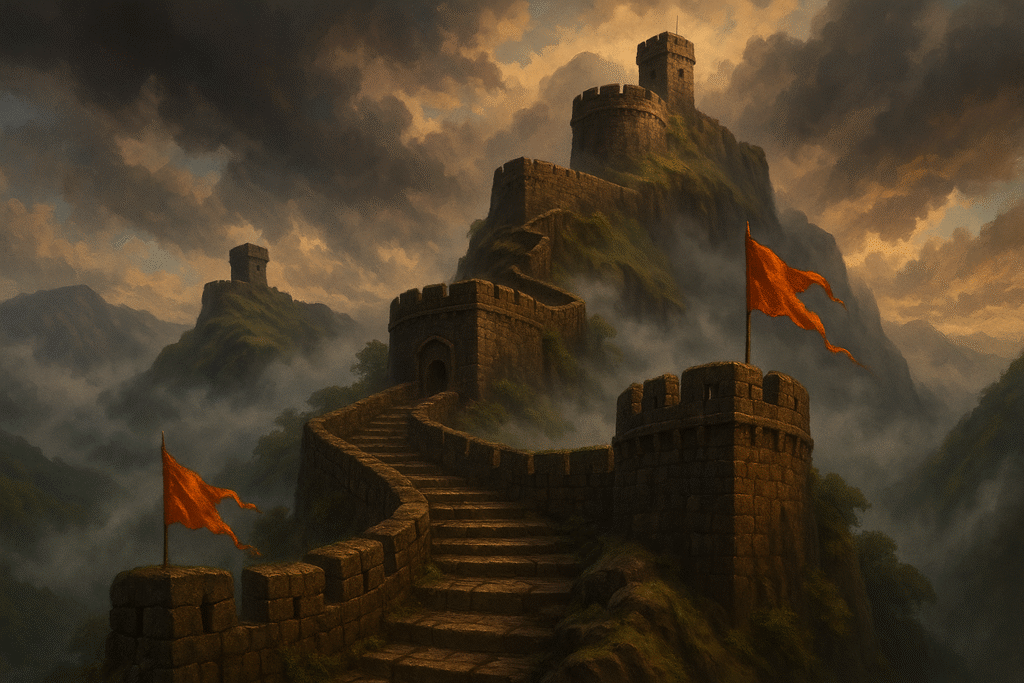
Location: Pune District
At the age of sixteen, Shivaji took control of Torna, the first fort he had taken. The Maratha Empire began with this conquest. Torna is renowned for its expansive views and abundant biodiversity, as well as its enormous stone structures, bastions, and intricate defences.
Key Features:
- Budhla Machi and Zunjar Machi (Watch Points)
- Gates of History
- Large fort walls
- Water tanks and holy places
- A well-liked location for trekking
5. Lohagad Fort
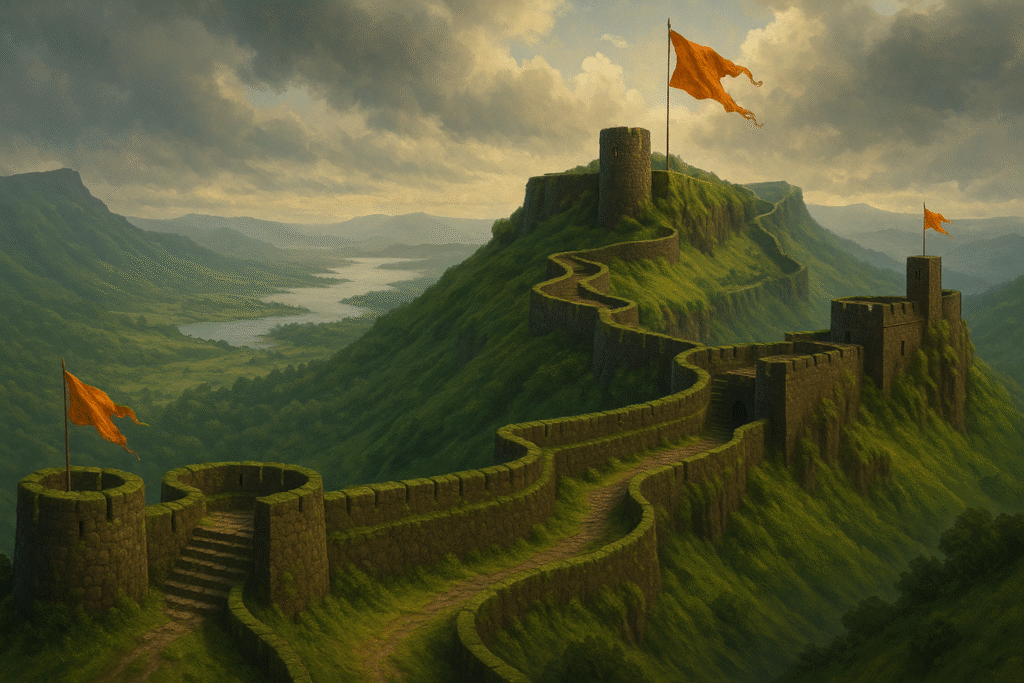
Location: Lonavala region, Pune
The treasure looted from Surat was kept in Lohagad, which means “Iron Fort.” It played a crucial role in Maratha logistics and was connected to its twin fort, Visapur.
Key Features:
- Vinchu Kata (Fortification Shaped Like a Scorpion Tail)
- robust gates and outer walls
- Caves and temples
- Natural water tanks and lush vegetation
6. Sinhagad Fort
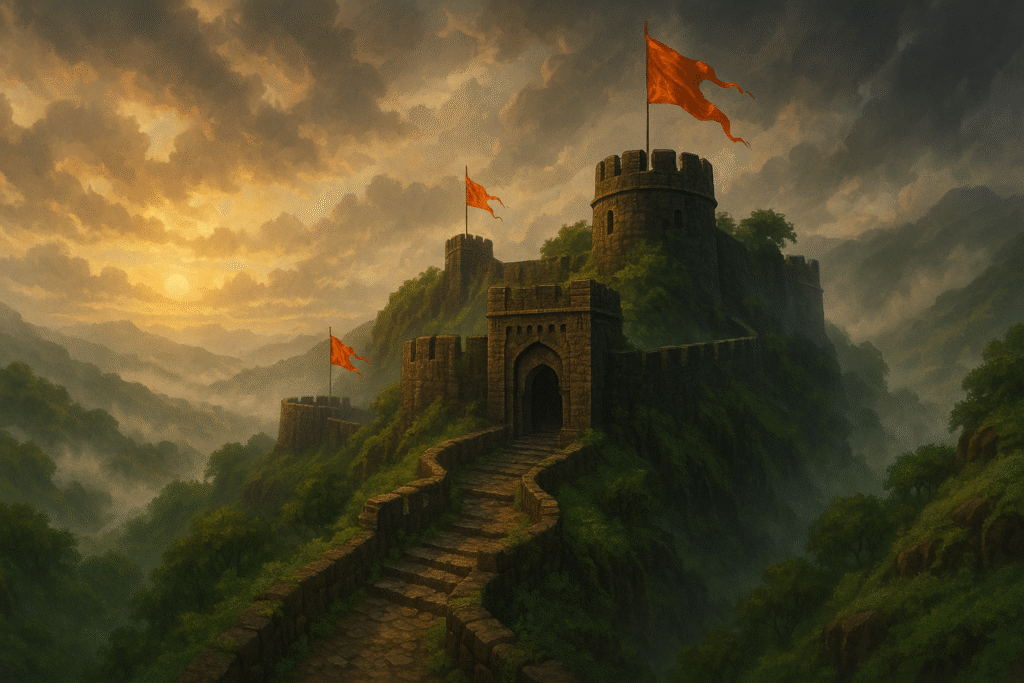
Location: Southwest of Pune
This fort, which is well-known for the bloody Battle of Sinhagad in 1670, where Tanaji Malusare gave his life, is a testament to courage and loyalty. It was crucial in securing Pune.
Key Features:
- Pune Darwaza and Kalyan Darwaza
- The Memorial of Tanaji Samadhi
- Magnificent Views
- Barracks, grain stores, and military stables
7. Salher Fort
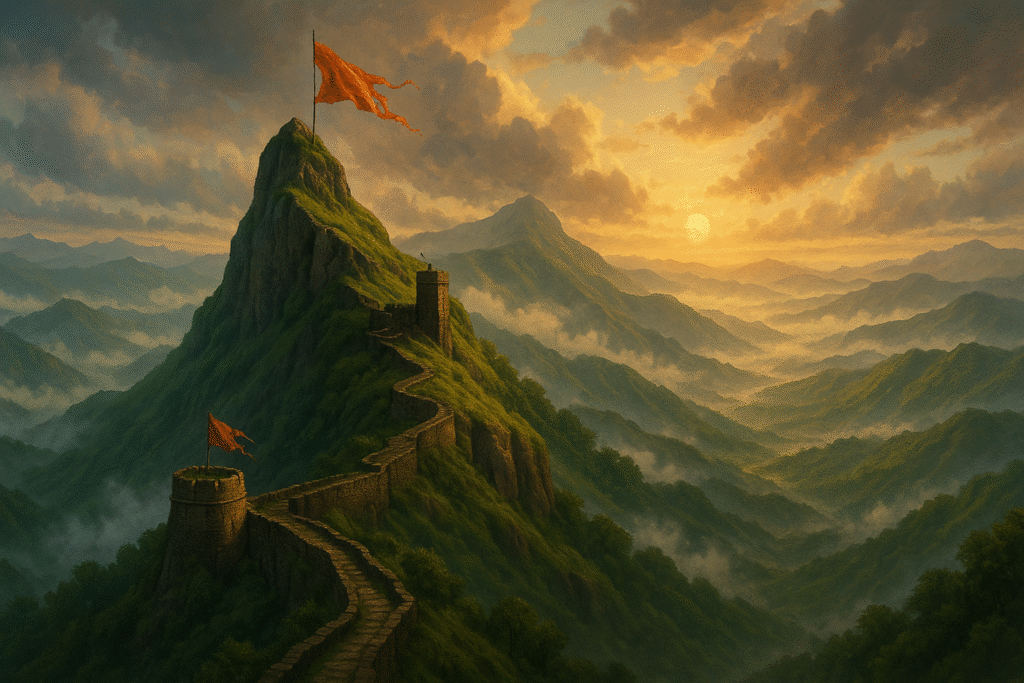
Location: Nashik District
One of the tallest forts in the Sahyadri range, Salher was the scene of the famous Battle of Salher in 1672, in which the Marathas fought an open-field victory over the Mughals. It functioned as a Maratha Empire outpost in the north.
Key Features:
- Sahyadris Panoramic Views
- Remnants of Battle
- Caves and Water Cisterns
- Temples and steps carved out of rock
8. Sindhudurg Fort
Location: Malvan, Konkan Coast
Built as a naval base on an island in the Arabian Sea, Sindhudurg was overseen directly by Shivaji. More than 4,000 pounds of lead were used in its construction to reinforce the foundation.
Key Features:
- Main Entrance Hidden
- Shivaji’s Footprints and Hand
- Shivaji Temple
- Secret escape routes and freshwater wells
9. Suvarnadurg Fort
Location: Ratnagiri District
Suvarnadurg, another sea fort, was essential to naval defence. It was essential in warding off foreign navies and had shipbuilding facilities.
Key Features:
- The nearby Maritime Museum
- Watchtowers and Lighthouses
- Storage chambers and tall sea walls
10. Vijaydurg Fort
Location: Sindhudurg District
Often referred to as the “Eastern Gibraltar,” this fort was almost impregnable. It featured an underwater trench to block enemy ships, a dry dock, and triple-layered walls.
Key Features:
- The underwater wall
- Bastions and Watchtowers
- Remains of the Naval Dockyard
- Covert tunnels
11. Khanderi Fort (Kanhoji Angre Island)
Location: Near Alibaug, Maharashtra
Shivaji constructed Khanderi to protect the sea route to Mumbai. Later, Admiral Kanhoji Angre of the Maratha Navy fortified it to protect it from attacks by Portuguese and British ships.
Key Features:
- The Lighthouse
- Underground rooms and barracks
- Point of Strategic Coastal Defence
- Arabian Sea panorama
12. Gingee Fort (Jinji Fort)
Location: Tamil Nadu
During Shivaji’s southern campaigns, Gingee Fort, also referred to as the “Troy of the East,” briefly came under Maratha rule. One of the most robust hill forts in India, it is dispersed over three hillocks.
Key Features:
- Huge Temples and Walls
- Halls of Audience and Granaries
- Tall towers and defensive trenches
Cultural and Strategic Significance
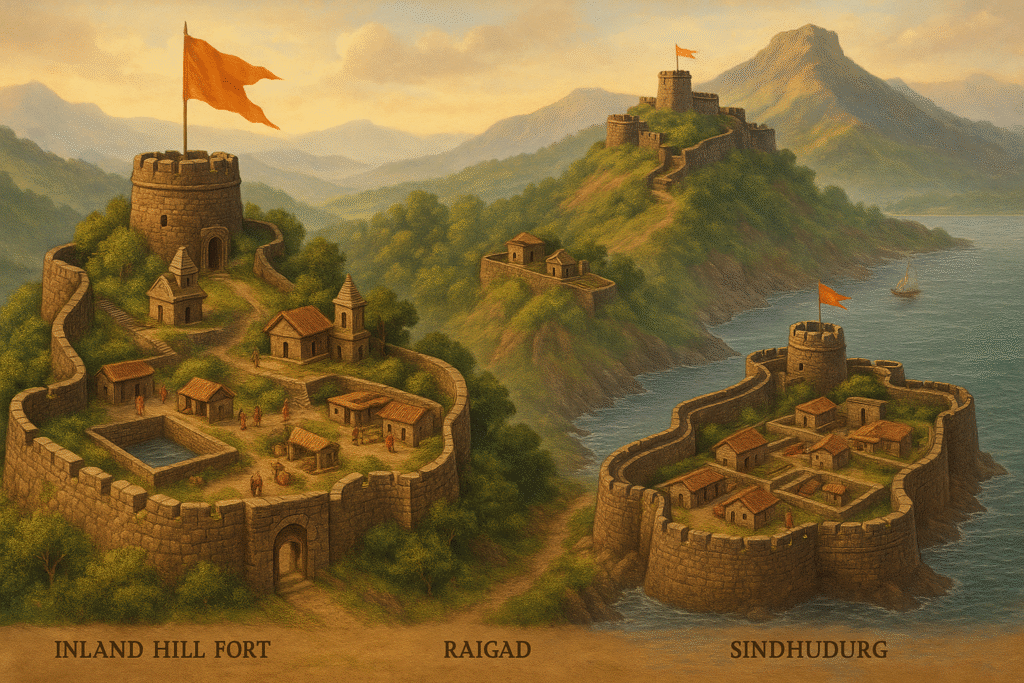
These forts each exhibit a distinctive fusion of community planning, water management techniques, natural defences, and military architecture. They are outstanding illustrations of how defence tactics were incorporated with geography. These buildings, which ranged from inland hill fortresses to naval bases, allowed Shivaji Maharaj to establish a highly efficient yet decentralised government.
Shivaji’s inclusive and community-focused governance is reflected in the religious and cultural elements found in many forts, such as temples, marketplaces, and residential areas.
Why the UNESCO Recognition Matters
UNESCO’s recognition highlights the global importance of these forts and offers opportunities for:
- International Tourism
- Cultural Exchange
- Government Support for Preservation
- Global Awareness of Maratha History
It puts India’s Maratha heritage on the world map, invites global scholars to study indigenous architecture, and creates local job opportunities through tourism.
Conclusion
The genius of a leader who understood how to construct, defend, and rule is reflected in the 12 forts of Chhatrapati Shivaji Maharaj that are recognised as UNESCO World Heritage Sites. The tale of a ruler who never submitted to oppression and who dreamed of a kingdom founded on justice and self-government is echoed by these forts.
It is a voyage into the spirit of Swarajya to visit these forts; it is more than just a travel experience. In order for our glorious past to continue inspiring future generations, these heritage sites call on us to conserve, safeguard, and promote it.
🔹 UNESCO Official Site – Forts of Shivaji Maharaj
https://whc.unesco.org/en/tentativelists/
Search for “Maratha Military Architecture in Maharashtra” or “Forts of Shivaji”
🔹 Archaeological Survey of India (ASI) – Forts and Heritage Sites
🔹 Maharashtra Tourism (MTDC) – Fort Tourism Section
https://www.maharashtratourism.gov.in
🔹 Incredible India – Historic Forts of India
https://www.incredibleindia.org
🔹 Google Arts & Culture – Chhatrapati Shivaji Maharaj
https://artsandculture.google.com/entity/chhatrapati-shivaji-maharaj
🔹 Academic Article – Maratha Military Architecture (ResearchGate)
https://www.researchgate.net
(Search: “Maratha Forts architecture” or “Shivaji military fortification”)
🔹 YouTube Documentary – Shivaji Maharaj Forts (History Channel India)
https://www.youtube.com/results?search_query=shivaji+maharaj+forts+documentary

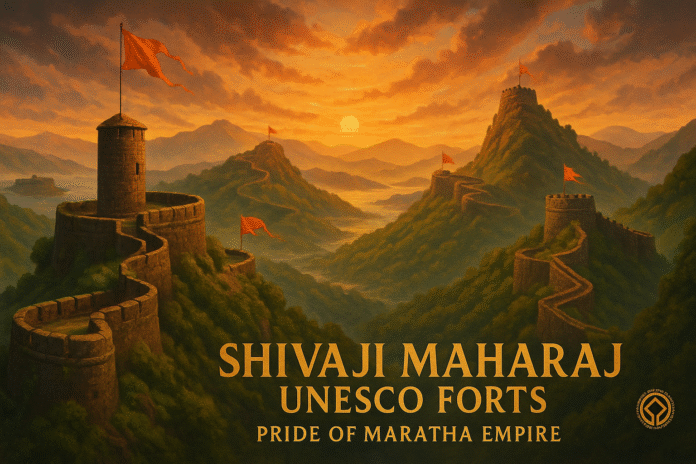



[…] 12 Forts of Chhatrapati Shivaji Maharaj UNESCO Forts World Heritage List […]